|
VAIL'S TEAM TO HAND OFF THE GRINDSTONESEPTEMBER 16 -- STONYFORD, CA: Smoke from the Grindstone complex filled the skies above Tehama County yesterday, with heavy winds pushing the smoke north toward Redding. Smoke on Sunday shrouded the Ukiah valley with a low pressure cell over Mendocino and Lake counties. The Mendocino County Air Quality Management District issued a health alert for those sensitive to air pollution, according to the Ukiah Daily Journal.
The Redding Record-Searchlight reported that winds are expected to shift tomorrow, moving the smoke toward Sacramento.
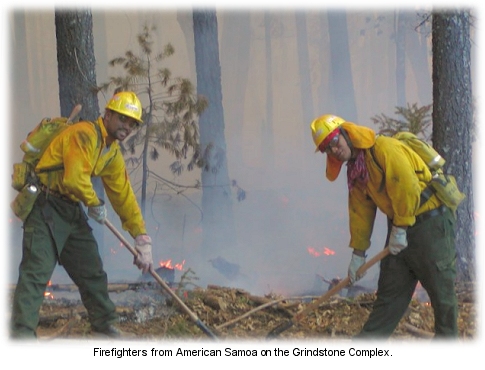
Driving times of two hours or more are causing travel delays and logistical problems for crews and other resources, so the team's instituted the use of coyote tactics, spike camps, and some 24-hour shifting on the fire. Crews yesterday burned out from existing dozer lines and continued mop-up; the Deafy Fire could still spread up the Anderson, Eel, and Cold Creek drainages. Fire behavior is expected to be moderate.
Deafy is the only active fire in the complex; 22 other fires have been controlled and 13 contained. Of the largest fires, the Deafy Fire is at 4,544 acres, the Happy Camp is 1,481, the Felkner is 407, the Anderson II is 284, and the Estelle Fire is 221 acres. The Bowman Fire near Ski-Hi was contained at 212 acres.
The fire perimeter amounts to about 54 miles of fire perimeter. The Deafy is the only one of the 39 fires on the 7,722-acre complex that's still active, and containment on the complex is at 35 percent. Vail's team will transition off the incident on Thursday morning.
Costs on the complex have reached $8.3 million, which is about 65 percent of the Mendocino National Forest's total costs for all the fires caused by the September 3 lightning storm. Fires at the forest's two other complexes -- the Smokehouse and Covelo -- were contained last week.
Forest officials closed portions of road M6 on Sunday afternoon, but the Gravelly Valley air strip and Forest Highway 7 were opened over the weekend.

FIRE SEASON TAB COULD RUN $950 MILLIONSEPTEMBER 15 -- SISTERS, OR: The Forest Service expects to spend at least $773 million on firefighting this fiscal year, about $355 million more than allocated in the current budget. And the total bill could reach $950 million before the 2003 season ends.
At a cost of $1 million per day, the B&B; Complex in Oregon has racked up an estimated $30.6 million in suppression costs since the fires started August 19. As of yesterday, 60 engines, 46 crews and 11 helicopters, with a total of nearly 2,000 personnel, were still on the complex, now 86 percent contained at 90,824 acres.
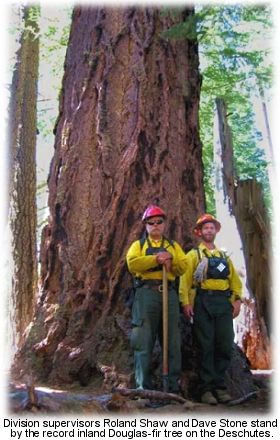 The record-size Douglas-fir within the perimeter of the complex, contrary to rumor, was not killed by the fire. The record-size Douglas-fir within the perimeter of the complex, contrary to rumor, was not killed by the fire.
According to the Statesman-Journal, crew costs on the B&B have run from $5,500 per day for a hotshot crew to a range of $7,000 to $11,000 per day for a contract crew. About a third of the total cost for the complex is wages -- mostly for hand crews, engine crews, and other front-line personnel. About a fifth of the cost has paid for equipment -- the operation of engines, dozers, trucks, and other ground equipment.
The usual big-ticket item in suppression expenses is aircraft. An airtanker making a 2,500-gallon drop can run about $4,000 per load. Heavy helicopters, which can deliver 10,000 gallons per hour, run $25,000 or more per day. Another $2 million on the B&B Complex was spent on supplies, the caterer's reimbursement has run about $70,000 per day, and an 8-person shower unit runs between $2,200 and $2,600 per day.
The cost of the B&B pales, though, compared with the $155 million spent on last year's 500,000-acre Biscuit Fire in southern Oregon -- the largest in at least a century.
Ken Snell, regional deputy director for fire and aviation with the Forest Service and BLM, said two major factors have increased the costs of wildfire suppression: sustained drought in the West, and increased fuel loads in overgrown forests.
"We're finally paying the price," said Snell.
When fire funds ran out last month, Forest Service managers had to divert funds from other programs to pay for suppression. The Casper Star-Tribune reported that this year's fires will cost about $355 million more than what was allocated in the budget. To cover the difference, the agency took money from other programs -- such as maintenance, research, brush disposal, and recreation.
In July, some members of Congress voted against an emergency disaster relief bill after House leaders stripped $289 million in fire suppression funds from the bill. The measure was passed 352-60.
The omission of the firefighting money left many Western lawmakers seething. U.S. Rep. Barb Cubin of Wyoming, for example, is continuing to press for an emergency allocation.
"She's outright just demanding that money get back there for that," said her press secretary Joe Milczewski. "She's letting everyone know that it's just ridiculous not to have wildfire funding."

WEEKEND FIRE BURNS 700 ACRES NEAR BILLINGSSEPTEMBER 15 -- LOCKWOOD, MT: With the Montana fire season winding down after the onset of fall rain and cooler temperatures, residents found yesterday that fire danger's still pretty high. A 700-acre fire yesterday afternoon burned two structures and threatened nearly 30 homes in the Pine Hills area of Lockwood, a subdivision of steep hills about 8 miles east of Billings.
Incident Commander Robert Guenther with the Lockwood Fire Department told the Billings Gazette that the Pine Hills Fire was nearly contained by sunset. The fire started at about 1:30 p.m. on the east side of Interstate 90. Local residents said the fire ran up a valley and jumped a road, spreading quickly to the northeast. Guenther said state airtankers were especially helpful; two SEATs were on the fire about 90 minutes after it started, and a pair of heavy tankers followed.
"They played a critical role," said Guenther.
The fire was stopped early Sunday evening just short of Bill Weis's home. He stood on his porch watching snags burning inside the fireline. "We dodged a bullet," said Weis. "It's not a good thing when you look up and see an airtanker over your house."

SMOKEHOUSE CONTAINED, BUT CREWS
ON MENDOCINO WARY OF WINDSSEPTEMBER 12 -- STONYFORD, CA: Demobilization is wrapping up on the 1,210-acre Smokehouse Complex -- fully contained Wednesday evening -- and a target of this evening is set for containment of the Covelo Complex fires, according to the Ukiah Daily Journal. But a red flag warning issued Wednesday for high winds and hot conditions is still in effect, with winds of 20 mph or better continuing today across the Mendocino National Forest and the valley below.
Temperatures ranged from 83º to 93º and are predicted to increase. The 240-acre Covelo Complex is burning in timber about 15 miles east of Covelo, and according to Mullenix's Type 2 team, fire behavior was minimal yesterday.
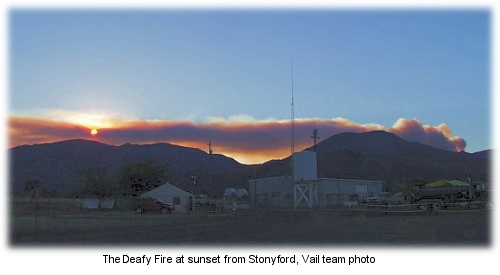
The Grindstone Complex, about 20 percent contained at 4,045 acres, has two major fires still active -- the Happy Fire at 1370 acres and the Deafy Fire at 925 acres. The Happy Camp and Felkner fires are expected to burn together, as are the Anderson II and Deafy fires. There are 39 confirmed fires on the complex; activity yesterday included flare-ups and short-range spotting on the Happy Camp Fire, with slow backing and flanking surface fire on the Deafy. Structure protection remains in place for 11 residences.
Red flag conditions could radically affect fire spread, according to Scott Vail's Type 1 team. The potential for the Deafy Fire to spread west is of particular concern if the current north winds rotate to the northeast and align with the Anderson Creek and Corbin Creek drainages.

FDNY ON THE B&BSEPTEMBER 11 -- SISTERS, OR: Two years ago today, in New York City, firefighter Harry Meyers was confronting a nightmare: the terrorist attack on the World Trade Center. Today Meyers and five others from the New York Fire Department are on the B&B Complex in Oregon, working with wildland firefighters and learning how the Incident Command System handles a large-scale long-term incident.
Two years ago Meyers, commander of the FDNY's Manhattan Borough, was on his day off in upstate New York. He headed for Ground Zero and was the operations chief in charge of the rescue effort. He didn't know where three of his sons were -- one NYPD officer and two FDNY firefighters -- until the evening, when he learned they were safe. He didn't leave the site for weeks.
"September 11 showed us we need to be more concerned with long-term events," he told the Bend Bulletin.
Austin Horan, a battalion chief for Lower Manhattan, said the B&B operation is exactly what the New York firefighters need to see. "FDNY has resources, manpower, and training," he said, "but we need to coordinate to give us back what we had before -- control."
Meyers has followed incident commander Kim Martin since Sunday, when the New York crew arrived at the fire camp. He was impressed with the way the tent city at the Sisters rodeo grounds emerged as if from nowhere.
The New York crew is the fifth group of six teams to visit wildfires this summer in a job-shadow program. The first four teams trained on Montana fires.
In August, FDNY personnel shadowed Bill Swope's type 2 team on the Cherry Creek Fire for a week in Montana.
"The ICS helped create organization out of chaos," said Mike McPartland, chief of Battalion 11 on the upper west side of Manhattan. "We saw it at work on 9-11 and realized we could learn it and use it, too."
Several Type 1 incident management teams were assigned to the disaster two years ago, and firefighters there were impressed with the teams' function there. "The level of organization and cooperation these people brought to the incident was incredible," said New York Battalion 18 Chief Ray Goldbach. "We see this as great training for the next big incident we face."

WITH GRATITUDESEPTEMBER 11: To all of you out there, whether you are wildland firefighters, volunteers, structural firefighters, law enforcement personnel, emergency medical responders, or support of any other kind in emergency services, on this day, in memory of those we lost -- THANK YOU.

RAIN HELPS ON THE B&B COMPLEX,
BUT WINDS EXPECTEDSEPTEMBER 10 -- SISTERS, OR:
Cooler temperatures and rainfall have allowed firefighters to engage in direct-fireline construction near Marion Lake; some areas got over a half inch of rain in the last couple days. Dale Gardner, the incident commander for the portion of the complex west of the Cascade Crest, said it's important that crews make good progress before the weather changes and east winds pick up. "The rainfall we've received to date has been helpful," said Gardner, "but has done little to change record-low fuel moistures in the large-diameter fuels."
Fire managers are expecting winds from the northwest at 8 to 12 mph in the higher elevations, with possible east winds gusting to 35 mph by Friday or Saturday.
The west side of the complex is estimated at 15,000 acres, with 12 crews assigned and more on order. Air resources are shared across the entire complex; seven heavy helicopters, three mediums, and two light helicopters are assigned.
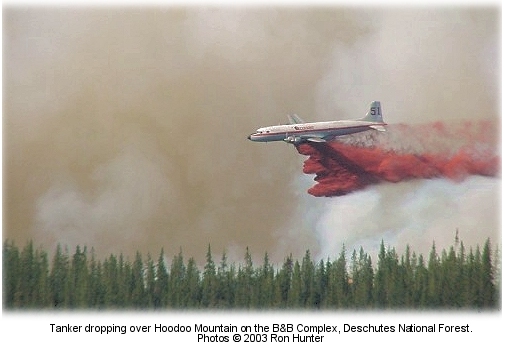
Highway 20 traffic is still delayed because of helicopter traffic over the road. Travelers are cautioned to watch out for vehicles and hazards such as trees, rocks, and limited visibility caused by smoke. Detailed road closure information is available on the complex website at bandbcomplex.com
The Register-Guard reported that fire danger on the Willamette and other neighboring forests dropped to a rating of "low" yesterday, down from "medium" on Monday and "high" last weekend. Fire information officer Robin Vora said he drove through the fire area yesterday, and only a few areas were actively burning.
"As far as I can tell, it's just a stump over here or a snag over there," he said. "There's no fire spreading."
Kim Martin's Type 1 team, which is handling the east side of the complex, said the fire's now grown to 90,452 acres, with 55 percent containment. More than 2,100 people are working on the fires. Over 42,000 acres of the fire is on the Deschutes National Forest; about 23,000 acres is in the Mt. Jefferson wilderness, 1,100 acres is private land, and nearly 4,000 acres is on the Warm Springs Confederated Tribes reservation. Burned area in the Mt. Jefferson wilderness is 17,300 acres, and another 2,700 acres are on the Willamette National Forest.

RED FLAG ON THE GRINDSTONESEPTEMBER 10 -- STONYFORD, CA: Brisk winds this morning have prompted a red flag warning on the Grindstone Complex, and firefighters are expecting high temperatures, low humidity, and more wind. The Grindstone Complex now includes three major active fires ranging between 150 and 600 acres.
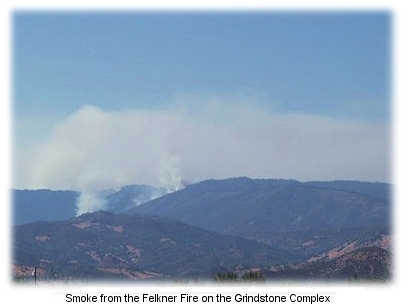 Weather problems and fire behavior are challenging suppression efforts on the Happy Camp Fire, the Happy Camp II Fire, and the Deafy Fire. Fire managers and making contingency plans for fires that are expected to burn together. Weather problems and fire behavior are challenging suppression efforts on the Happy Camp Fire, the Happy Camp II Fire, and the Deafy Fire. Fire managers and making contingency plans for fires that are expected to burn together.
The complex is estimated at 10 percent containment this morning, with 3,025 acres burned. There are 39 confirmed fires in the complex.
The Chico Enterprise-Record reported that the fires grew nearly 1,000 acres yesterday; the list of threatened residences was reduced from 21 to 11 when the Bowman Fire was contained.
Resources include 33 crews, 73 engines, 16 dozers, 13 tenders, two fixed-wing aircraft, and a dozen helicopters.
The Smokehouse Complex, also on the Mendocino, was 95 percent contained yesterday at 1,210 acres. There was no estimate on containment on the Covelo Complex, which is in remote country, but its size was estimated at 160 acres. Mullenix's Type 2 team has been assigned to the Covelo.

CODFISH FIRE MORE THAN HALF CONTAINEDSEPTEMBER 07 -- FORESTHILL, CA: The 830-acre Codfish Fire near Foresthill is about 60 percent contained today; it's burning on Codfish Ridge in steep and rugged terrain on the Tahoe National Forest.
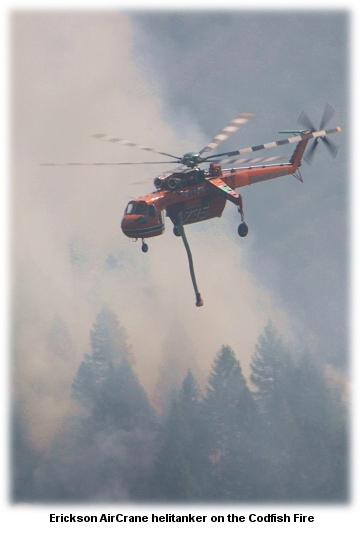 One of dozens of fires burning in northern California after lightning storms last week, the Cod Complex is being managed by the NorCal II team. One of dozens of fires burning in northern California after lightning storms last week, the Cod Complex is being managed by the NorCal II team.
Information Officer Anna Payne said burnout operations and contingency lines have been completed in expectation of forecasted increased winds this afternoon.
Some rehab efforts have begun, but the north fork of the fire is still active. Goals today include keeping the fire west of Deadwood Ridge, east of the West Branch of Eldorado Creek, and south of the Foresthill Divide road.
A Forest Service Fire Behavior Research Team has set up sites on the complex to study changes on fire behavior in areas of treated and untreated fuels.
According to the Sacramento Bee, fire crews will be busy enough this week that CDF has canceled all scheduled firefighters' days off for the week.

RED FLAG ON MONTANA FIRES TODAYSEPTEMBER 07 -- FRENCHTOWN, MT: The Fish Creek Complex on the Lolo National Forest, now 50 percent contained at 35,700 acres, is expecting red flag conditions this afternoon.
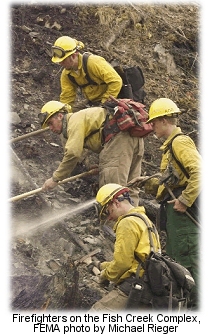 The Missoulian reported that firefighters in camps around western Montana last night were waiting for the "weather-changing pattern" predicted for today. The Missoulian reported that firefighters in camps around western Montana last night were waiting for the "weather-changing pattern" predicted for today.
It could bring rain -- but it's the winds that have people on edge.
Information Officer Christine Ayers on the Blackfoot Lake Fire said they've had no wind for a week, so the fires have sat and baked the moisture out of the forests.
At camp they hear the phrase "watch-out situation" about a thousand times an hour, she said.
"Before we get any rain, we could get major winds," Ayers said. "This weekend, everybody's on pins and needles."
Lohrey's Type 1 team is handling the Fish Creek Complex, and they have the U.S. Army Task Force Steel Dragon regiment assigned. The complex, which includes nine fires, is about 35 miles west of Missoula.
Structure protection is in place for 195 homes and one commercial property; firefighters worked yesterday on the east side of the Thompson Creek Fire where the fire burned across containment lines on Friday. They will continue mop-up around the fire today to close in the remaining gaps on the north and south flanks.
A combination of windy conditions, low humidity, warm temperatures, and an unstable air mass will combine to produce Red Flag conditions this afternoon and evening, along with isolated thunderstorms and wind gusts up to 40 mph. The forecast says rain will come at 10 p.m., and it will rain all night, according to Information Officer Andy Williams.
"The weather has changed," he said. "There's high clouds, and the wind has sort of freshened a bit. There's a sense that something is changing." A red flag was issued by the Weather Service for gusty winds in the Idaho Panhandle, with fire weather watches issued for gusty westerly winds and low humidity in portions of Idaho and western Montana. A cold front with rain will move across the Pacific Northwest today and into Idaho and western Montana tonight.

FIRE NEAR ASHLAND THREATENS 70 HOMESSEPTEMBER 07 -- ASHLAND, OR: Fires ignited by lightning in the hills south of Ashland are threatening some 70 homes; burning in timber, slash, brush, and grass, the 9-05 Complex of 21 fires has closed the Dead Indian Memorial Highway. The fire, at 675 acres, was estimated at 75 percent containment last night.
Oregon Department of Forestry Fire Prevention Specialist Dennis Turco told the Ashland Daily Tidings they're watching for a wind change. "We're expecting possible westerly winds at 6 to 12 miles," he said. "Anytime you get wind it can cause problems for us."
The fire was reported late Friday afternoon; lightning has set off more than 50 fires in southern Oregon since Thursday. Airtankers worked the fires, which were burning in steep terrain. Containment is predicted for tonight.

BRIDGE FIRE THREATENS 1,500 HOMESSEPTEMBER 06 -- SMILEY PARK, CA: A brushfire pushed by erratic winds is threatening about 1,500 homes east of Los Angeles today, with at least 400 home evacuated along the edge of the San Bernardino National Forest. Domanski's Type 2 team is working with the Running Springs Fire District and the San Bernardino County Fire Department on the fire, which is threatening to burn into bug-kill timber and heavy brush in high-density interface areas.

Highway 18 is closed between Sky Forest and Big Bear dam, and only residents are being allowed through. Highway 330 is closed from Live Oak at the tip to Highland at the bottom, and mandatory evacuations have occurred in seven different communities. Structure protection is in place for 1,500 homes, and more erratic winds with possible thunderstorms are forecast.
The fire took off yesterday afternoon and burned about 1,400 acres by evening. According to the San Bernardino County Sun, the fire exploded out of the foothills north of Highland; a high school in Lake Arrowhead was designated as evacuation headquarters. By 8 p.m. about 500 people were at the high school.
The speed of the fire stoked fears that it might be the monster blaze everyone has been dreading. Firefighters said Friday night that they could not predict when the evacuees could return to their homes; the fire is expected to burn through the weekend.
Two firefighters were treated for heatstroke, and a third may have suffered a back injury. Forest Service officials said last night they had requested additional airtankers and helicopters.
The fire was first reported about 3:00 p.m. west of Highway 330, and it grew from 8 acres to 100 acres in about an hour. By 5:00 p.m. evacuation orders had been issued for 250 homes in the Smiley Park area of Fredalba, the lowest-lying community along the highway.

About 1,100 firefighters were working the fire, with 65 engines, 24 crews, eight airtankers, two helicopters, seven dozers, 14 water tenders, and a pair of air-attack planes assigned. Officials credited the airtankers with saving structures.

B&B COMPLEX TAB REACHES $17 MILLIONSEPTEMBER 06 -- SISTERS, OR: Crews held their lines overnight on the B&B Complex, keeping the Booth and Bear Butte fires from spreading into commercial timber on the Confederated Tribes of Warm Springs reservation. The two fires have burned together and now cover 83,000 acres, according to a report by KATU-TV, with over 2,000 firefighters assigned.
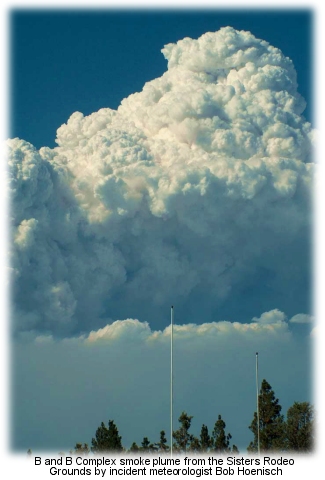 Camp Sherman was evacuated again on Thursday when the fire burned to within three miles of the community. Camp Sherman was evacuated again on Thursday when the fire burned to within three miles of the community.
The fire yesterday burned another four miles in under an hour, sending a plume of smoke up to 35,000 feet and raining down embers and ash.
Incident commander Bob Anderson met with Camp Sherman residents yesterday.
"I'm sorry we all meet again in the evacuation center," he said. "We saw some very erratic fire behavior yesterday."
The complex suppression costs now have reached $17 million.
Another Type 1 team is on order; the fire's burning in timber with heavy ground fuels on the Deschutes National Forest west of Sisters. An inversion yesterday in the Metolius River drainage slowed the fire till mid-afternoon; structure protection is in place for 120 homes and 13 commercial properties.
Local residents barely had time to return home from an evacuation before they got the order to pack up and leave again.
"It's been nerve-racking," said Virginia Dick. "I have had more fun than this. All the adventure wears off after about one day."

GRINDSTONE COMPLEX -- 55 FIRES AND NO ROADS INSEPTEMBER 05 -- STONYFORD, CA: The Grindstone Complex on the Mendocino National Forest tonight includes over 650 acres, comprising 55 different fires in the foothills west of the northern tip of the Sacramento Valley. Vail's Type 1 team late today said that 11 of the initially identified fires on the Grindstone Complex were contained -- fires ranging from under one acre to over 100 acres.
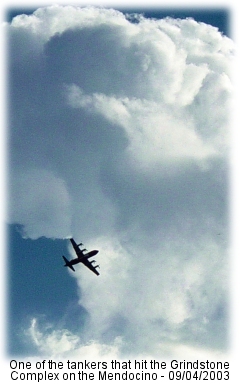 The largest of those today was the 170-acre Bowman Fire. The largest of those today was the 170-acre Bowman Fire.
The Smokehouse Complex in Lake County was estimated at 250 acres with 13 active fires; the Covelo Complex included six fires of 111 acres. Four new fires were identified this afternoon, but all were 30 acres or less.
Just west of the Bowman Fire, a priority today was the protection of the Ski-Hi community of cabins, a small group of privately owned residences adjoined by private timberland and national forest land. Most of the remote properties in the area are owned by local residents who have, for several decades, provided wildland fire safety for themselves and their neighbors -- defensible space with or without the help of the Forest Service and other regional funding sources for wildland-urban interface fuels reduction projects.
Mostly they've just done it on their own -- when federal funding grants for such projects were turned down -- and some of those mountain residents yesterday had firefighters camping in the meadow outside their cabins.
The steep slopes, drought-parched foothills, and chaparral-choked drainages cause long-time residents and fire-savvy veterans to shudder when they consider late-summer fire on the Mendocino. It was 50 years ago this summer that the Rattlesnake Fire, just a few miles north, killed off a crew of firefighters in the same fuels in the same country in the same kind of weather.
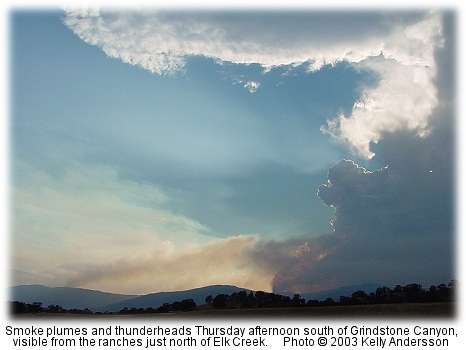
Firefighters on the Grindstone Complex have been keeping an eye on the weather forecasts; predicted southerly winds and low RH are only one of the challenges. Another is access -- or lack of it. There are but a few ways to get to a fire. Firefighters can hike in there, drive there, fly there, or parachute there. And on the Mendocino -- the only one of California's 18 national forests that's not crossed by a paved road -- that's a problem when it comes to wildfire suppression.

MONEY TO BURN??SEPTEMBER 05 -- WASHINGTON, DC: Congressional investigators say that $3 million in "improper, wasteful, and questionable purchases" has been made by U.S. Forest Service employees -- over $1 million of which was on government credit cards.
ABC news reported today that much of this was done in the name of Smokey Bear. An audit released today by the General Accounting Office cites the Forest Service for what was called "improper, wasteful, and questionable purchases," including:
- $4,843 in premium cable TV channels for forest rangers
- $1,031 in jewelry from Meier & Frank in Salt Lake City
- $2,295 for a bunkhouse pool table
- $12,250 for two fish costumes and a salmon tent to promote Smokey Bear
According to the ABC report, the expenses total over $2 million. The GAO report cited the risk of "waste, fraud, and abuse" at the same time that nearly every non-fire program or budget area in the U.S. Forest Service has recently had to fork over its budget for fire suppression -- because of the Congressional refusal to fund federal fire suppression without the necessity of federal "borrowing" from non-fire budgets in time of fire budget crises.
Senator Charles Grassley of Iowa told Agriculture Secretary Ann Veneman that she's accountable.
"There tends to be an attitude that it is the government's money," he said. "There isn't anything like 'the government's money'; it's all taxpayer money."
There weren't any reports available on how Grassley thought federal fire should be funded. He said he thought government employees should be "the most trusted people in all the world."

$50,000 REWARD FOR ARSONISTSEPTEMBER 05 -- UKIAH, CA: A rash of suspected arson fires in Mendocino County has prompted investigators to issue a call for public help. In the last two weeks, according to the Press-Democrat, a dozen suspicious wildland fires have started in Mendocino County, including two that were set within two hours of each other along Highway 101 north of Laytonville. The fires cost CDF at least $400,000 to fight.
Since then, firefighters suspect that numerous other local fires may be arson-caused, including fires near Ukiah High School, near Mill Creek Road, and around Lake Mendocino.
"We're experiencing an unusual number of suspicious fires this season," said Tracy Boudreaux with CDF in Willits. She said people can call the local hotline number at 459-7422.
"We need every bit of help we can get," said CDF's Karen Terrill. She explained that people calling an arson hotline at (800)468-4408 can receive up to $50,000 for information leading to the arrest and conviction of an arsonist.

NEEDLE FIRE DOUBLES IN SIZESEPTEMBER 05 -- MAZAMA, WA: The Needle Fire on the Okanogan-Wenatchee National Forest has doubled in size to 6,000 acres, according to a report by KIRO-TV. Berndt's Type 2 team is on the fire, which is burning downhill on both sides of the Methow River and into Trout Creek northwest of Mazama.
Okanogan County sheriff's deputies went door to door yesterday to about 75 homes to warn residents to be prepared to evacuate. About a third of the residences are year-round homes, the rest vacation cabins. The fire was ignited by lightning early in August, part of the Fawn Complex of fires, but had held at about 20 acres till last weekend. The fire has closed a portion of the Pacific Crest Trail near Harts Pass.

NORTHERN CALIFORNIA LIGHTS UPSEPTEMBER 05 -- REDDING, CA: More than 5,000 firefighters have been dispatched to scores of lightning fires across northern California, and dispatchers are scrambling for more resources from other regions. Veteran firefighters are remembering the season of 1987, when an August lightning storm set off 1,200 fires that burned 740,000 acres. Eleven firefighters died.
The Sacramento Bee reported that the Codfish Fire on the Tahoe National Forest was burning on steep, rocky slopes east of Foresthill.
"This is definitely a hotshot fire," said Dewey Rebbe, a hotshot from New Mexico. "The ridge is steep, inaccessible, roadless."
The fire camp on the complex was nearly deserted yesterday, with crews on the ridge in spike camps.
"Once they're on the line, it's easier just to keep them out there," said Anna Payne, a fire information officer on Wendt's Type 2 team. "And it's safer. They'll be there in case the fire flares up during the night."
The complex was reported last night at 550 acres, with containment estimated at 15 percent. Another complex of fires across Tehama and Glenn counties, totaling over 700 acres, was nearly contained last night, but the Smokehouse Complex northeast of Potter Valley had reached 250 acres with no containment. Szczepanik's Type 2 team is assigned to the fire.
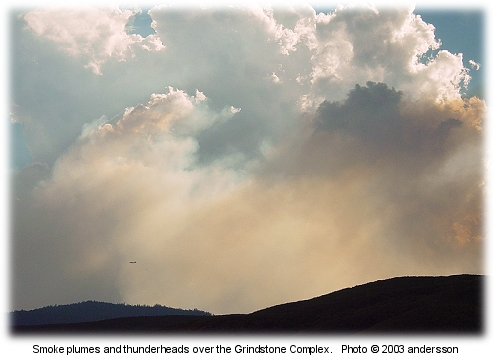
A Type 1 team headed up by Scott Vail took over the Grindstone Complex on the Mendocino National Forest yesterday afternoon. It includes more than 50 fires burning in chaparral on steep slopes west of Elk Creek, and was estimated last night at 450 acres.

FEDERAL OFFICIALS TO TEST JUMBO JETS FOR FIREFIGHTINGSEPTEMBER 05 -- RIVERSIDE, CA: The U.S. Forest Service has tentative plans to assign jumbo jets to airtanker bases next year, and plans to issue a request for proposals for new airtankers this fall.
"There are at least two efforts," said Tony Kern, the USFS aviation director. "One involves a DC-10. The other involves 747s. You'd never see a fleet of twenty of these things, but you might see a fleet of ten."
According to a report by the Press-Enterprise, the "supertankers" would carry between 12,000 and 24,000 gallons; Kern said no formal proposals have yet been submitted, but that Forest Service officials may issue a request for proposals early this fall for all categories of new airtankers, including jumbos. Consideration of the supertanker concept is part of the government's plan to modernize the national airtanker fleet; over the next five years, the USFS modernization plan calls for 50 firefighting aircraft.
"We're looking at a combination of large helicopters and fewer, newer airtankers," Kern said.
According to the plan, 30 to 35 of the large tankers would be fixed wing, and the other 15 to 20 would be heavy helicopters. "Those are invaluable when you're putting a fire out," said Dennis Hulbert, the Region 5 aviation director. "You get more gallons per hour delivered."
The modernization plan also calls for command-and-control aircraft to be equipped with infrared, and all command planes, airtankers, and heavy helicopters would be outfitted with automated collision-avoidance systems.

LIGHTNING RAKES NORTHERN CALIFORNIASEPTEMBER 04 -- REDDING, CA: A rash of lightning ignited more than 200 fires across northern California, and the California Department of Forestry scrambled about 4,000 firefighters yesterday to Lake, Humboldt, Mendocino, Sonoma, Napa, Shasta, Trinity, Tehama, and Glenn counties. Fire resources were stretched so thin that 37 fires couldn't be staffed, department spokeswoman Karen Terrill said. She said 22 of the fires have the potential to expand and become serious wildfires.
The 500-acre Cod Complex, burning on Codfish Ridge outside of Foresthill, threatened residences yesterday; it was ignited by lightning Sunday morning. Wendt's Type 2 team is managing the fires, and they estimated containment last night at 10 percent. Seven helicopters, 20 hand crews, and 33 engines with a total of 684 people were assigned to the fire, according to the Sacramento Bee. Two firefighters were treated for injuries, one for a bee sting and another for dehydration.
The complex includes the Codfish Fire and about 25 other lightning fires in the area, burning in heavy dead and downed fuels. The Tahoe National Forest recorded more than 300 lightning strikes yesterday, and reported 15 new starts this morning -- five of which are within the Cod Complex. More thunderstorms are moving in this afternoon, with a 20 percent chance of measurable precipitation.
The San Francisco Chronicle reported that in Lake County, the largest of two fires quickly grew to 3,000 acres in just a few hours. The Morgan Fire threatened about 200 structures outside of Middletown, about 70 miles north of San Francisco.
Today will be a busy one for fire crews. "There's going to be a lot of sleeper fires when the sun comes out," said Capt. J.W. Seely with the Sonoma County Department of Emergency Services.
The Redding Record-Searchlight reported that the storm knocked out electricity to more than 11,000 Pacific Gas and Electric Co. customers in Shasta and Tehama counties.
Firefighters were working on 45 lightning-caused fires just in Tehama and Glenn counties, most of which were contained by Wednesday afternoon. Another 10 fires were reported in Shasta County and 62 fires, most of which were under a quarter-acre, were caused by lightning on the Mendocino National Forest
In Mendocino County, firefighters hustled to contain 60 fires by mid-afternoon -- but were contending with another 60 as the day progressed. Most of those fires were near Willits, Covelo, and Laytonville. The lightning-caused wildfires were the third such outbreak of the season, and the worst thus far, said CDF spokesman Harry Martin.
"I can't recall the last time we had anywhere near this amount of fires from lightning activity," he said.
A fire burning a eucalyptus orchard south of Corning near Interstate 5 was causing firefighters headaches as six separate fires were burning together. Mickie Jakez with CDF in Tehama County, said crews from neighboring counties were called to help.
"We've been able to get on them pretty fast," she said. Two strong thunderstorms, which passed over Red Bluff around 3:00 and 3:30 p.m., knocked out power at CDF's headquarters. "The thunder was pretty bad passing over," she said. The storm dropped rain for about 10 minutes.
Tammy Hay with CDF in Shasta County said there were 10 confirmed lightning fires in Shasta County, mostly near Cottonwood and Anderson. "They are all over the place," she said.

FIRE THREATENS TOWN AND CLOSES I-84SEPTEMBER 03 -- CASCADE LOCKS, OR: A fire edged dangerously close to Cascade Locks yesterday, forcing dozens of people to evacuate and closing 47 miles of Interstate 84 about 40 miles east of Portland. The fire burned a former bed and breakfast on the edge of town, destroyed at least one other home, and threatened many others.
Firefighter Dennis Klein and his partner were the first two firefighters on the edge of the Herman Creek Fire, according to the Statesman Journal. They said the fire raced across a grassy field, jumped Interstate 84 and took off toward the town's eastern edge about a mile away.
"We watched it scream on by," said Klein. "It ripped down that mile in about 20 minutes."
The fire was 20 percent contained at about 475 acres this morning, with several hundred firefighters working hot spots and mopping up.
FOX news reported that the fire started in dry brush alongside the interstate. Two helicopters and three airtankers worked the fire; fire officials diverted a source of non-potable water into city pipes to get more water to the fire.
Union Pacific Railroad stopped trains along the south bank of the Columbia River because railroad ties were burning.
The fire caused serious traffic problems as far away as Portland. Oregon State Police said fire on both sides of the highway and zero visibility made for a dangerous situation. On I-84, detours continued today between Troutdale and Hood River. Oregon Department of Transportation officials said downed trees and guardrails remained a hazard and the interstate would not be re-opened until they were cleared. No estimate for re-opening was available; truck traffic was detoured on Highway 26 around Mount Hood, and passenger cars were sent across the Columbia River and down Highway 14 on the Washington side. Bridge tolls were waived during the detour.
Rail traffic reopened today. The Oregon Department of Transportation has Cascade Locks road cams and a road closure notice online.

FIRE CONTRACTING "A DANGEROUS GAME"??SEPTEMBER 02 -- PORTLAND, OR: Oregon's contract firefighting industry has grown dramatically in the last few years, and some estimate that the state is home to more than half the fire contractors in the country. But oversight of the industry hasn't grown as rapidly as the business, and that worries some government officials.
Several recent vehicle accidents, and an overall rise in vehicle incidents over the last few years, have prompted more concern about the future of the contracting industry, according to an AP story in the Register-Guard. And the state has failed to adequately monitor contract firefighting, said John Venaglia, who oversees crew contracts for the National Interagency Fire Center in Boise.
"It's a dangerous game they're playing," he said. "It's going to result in problems, and it already has."
The number of crews has roughly quadrupled in five years, while U.S. Forest Service staffing has plummeted. Under Venaglia's system, 50 of 52 national crews trace their roots to Oregon. Another 298 crews are dispatched all over the West. And he says all but a few are from Oregon.
"We've become a source for the nation, but we don't have the resources to adequately deal with the growth," said Bill Lafferty, the Oregon Department of Forestry's fire program director. "We've got some rough spots, and most of those are in government's capacity to ride herd on the work force."
For years, industry leaders have pressed the state of Oregon, which is responsible for administering Pacific Northwest contracts for the federal firefighting agencies, to maintain better monitoring of contract crews. And ODF last year suspended 10 crews for a variety of problems. Five crews have been suspended this year, for problems from marijuana use to poor performance to sexual harassment.
Another recurring problem is competency in English; this year the state has written eight "letters of concern" to contract companies about language competency. The number of Spanish-speaking crews has grown tremendously in the last few years, and fireline inspectors say their efforts to enforce the language requirement are met with charges of racism. An AP story in the San Francisco Chronicle explained that a fire crew last year on a fire in southern Oregon was nearly overrun by fire when they failed to understand warnings shouted at them in English. "That's a dangerous situation," said Ed Daniels, training manager with ODF, who investigated the account.
It's estimated that Hispanics make up more than 60 percent of the contract crews in the Pacific Northwest -- and many of them can't speak English or understand it. The Pacific Northwest Wildfire Coordination Group has strengthened language requirements; on any 20-person crew, the boss and the three assistants must speak English fluently. And all fire communication on the radio must be in English.
Some employers refuse to hire firefighters who don't speak English; they say language barriers create avoidable dangers.
"Fires are spoken in English," said Rick Dice, president of the National Wildfire Suppression Association, a professional organization that includes 125 contracting members in Western States. Dice said the lack of English is usually synonymous with little experience on fires.
ODF this year has sent home six crews before they even started working because they didn't meet the English requirements.

AUSSIES AND KIWIS BACK IN MONTANASEPTEMBER 02 -- HAMILTON, MT: Nearly 50 fire overhead from Down Under arrived in Montana over the weekend, the third time in four years that reinforcements from Australia and New Zealand have helped out on U.S. fires.
They arrived in Boise, according to the Ravalli Republic, last Wednesday and have been assigned to fires including the Cooney Ridge Fire, burning in three counties, most actively near Clinton, and the Trapper Creek Complex northeast of Kalispell.
The Scoop in New Zealand reported that their National Rural Fire Officer, Murray Dudfield, said the firefighters are all experienced in management and supervision. "At this moment more than 30 uncontained wildfires are blazing across the state of Montana burning over 120,000 hectares," he said. "They have caused hundreds of millions of dollars worth of damage and cover vast areas. The largest fire has so far destroyed almost 10,000 hectares."
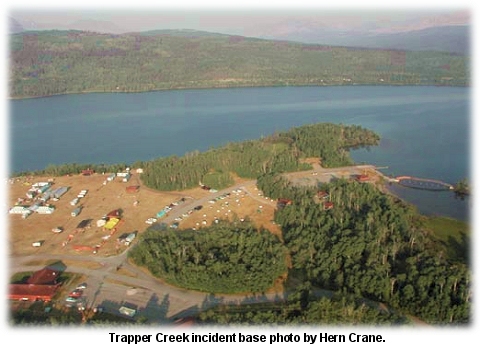
The Age reported that the group includes 16 firefighters from New South Wales, comprising members of the Rural Fire Service, State Forests, National Parks and Wildlife Service, and the NSW Fire Brigade.
The New Zealanders left Auckland last week for the National Interagency Fire Center in Boise, and won't return for 35 days.
Imported firefighters worked on fires in Montana during the 2000 season, and worked on several Oregon fires last year. The personnel include strike team leaders, division supes, helicopter managers, and specialists in operations, planning, logistics, and infrared mapping.
The fire managers work here under an international agreement drafted during the 2000 fire season.
The Trapper Creek Complex and Rampage Complex are online.

SCOTT NIEDERMAYER BRINGS STANLEY CUP HOME FOR FIREFIGHTERSSEPTEMBER 02 -- CRANBROOK, BC, CANADA: New Jersey Devils defenseman Scott Niedermayer showed up in his hometown on Saturday with the Stanley Cup -- as a morale booster for the hundreds of firefighters who've been fighting fire on his home turf.
"They are having some pretty long days, tough days," said Niedermayer, "so if this will put a smile for a minute that will be good. That's tough work they're doing, long days, so we owe them a lot of thanks for the work that they do."
Fire crews were thrilled, according to a story with nhl.com, to see both the Stanley Cup and Niedermayer, who was a key force in the hockey playoffs against Anaheim.
The Lamb Creek Fire southwest of Cranbrook has forced about 200 residents from their homes, and burned more than 100 square kilometers of forest -- nearly 25,000 acres. Aircraft have been dropping retardant and crews have been chasing spot fires and clearing powerlines. Niedermayer said it's unsettling watching the fire burn the area where he grew up. Hundreds of locals lined up in a hockey arena to have photos taken with their hometown hero and the Stanley Cup; Niedermeyer's mother asked him to take the cup to fire camp late Saturday evening to thank the exhausted firefighters.

CALIFORNIA FIRE FORCES 50 FIREFIGHTERS
TO DEPLOY SHELTERSAUGUST 29 -- MORGAN HILL, CA: About 50 firefighters on the Devil Fire in southeastern Alameda County deployed shelters early today in a flare-up that injured two people. At about 2 a.m., according to the Contra Costa Times, hand crews with the state Department of Corrections were working near a ridge when the fire flared up. They moved to a safety zone and deployed shelters. George Hoyt with CDF said two firefighters suffered minor burns; the rest returned to work after the incident.
According to the Morgan Hill Times, at least 25 fires were ignited in the Diablo Range east and northeast of Morgan Hill into Alameda and Stanislaus counties. The Devil Fire yesterday was at 487 acres with about 15 percent containment, the Hamilton Fire was at 462 acres with 50 percent containment, the 3,832-acre Jump Fire was 30 percent contained, the 60-acre Kincaid Fire was 40 percent contained, and the Annie Fire was 40 percent contained at 3,874 acres.
Strong afternoon winds and steep, inaccessible terrain were slowing containment efforts. The incident command post was established in Dublin, with 800 firefighters in base camp at Christmas Hill Park in Gilroy. The Annie Fire, burning off Highway 152 near Henry Coe Park, has been a major challenge.
"It's remote, the access is horrible, extreme," said Chris Morgan, fire prevention specialist for CDF. "The firefighters have had to walk quite a distance just to get to the fire. Our needs are crew and aircraft."
Jeff Harter, CDF division group supervisor, said when they got to the fire at 11 a.m. Wednesday, it was at 500 acres. By 4 p.m., the fire had quadrupled in size. Local residents said the Upper Quinto Canyon Creek area hadn't burned in several decades.
The Santa Clara Complex was at over 18,450 acres by this morning and was estimated at 50 percent containment. More than 2,300 firefighters are assigned. The worst of the fires in the complex is the Annie Fire, north of State Highway 152 and east of Henry W. Coe State Park near Morgan Hill.
"The winds are extremely changeable," said Hoyt. "It's really, really wicked wind in some of those areas."
About 55 homes and other buildings are threatened by the fires. According to an AP story in the Herald-Tribune, the grass fires burning in rural areas around the San Francisco Bay area have doubled in size to nearly 20,000 acres. The fires were ignited last Monday when a lightning storm -- unusual for this time of year -- rolled over the Bay Area.

ROLLOVER INJURES FIVE FIREFIGHTERSAUGUST 29 -- JOSEPH, OR: Five firefighters on the Lightning Complex near Hells Canyon were injured last night when their vehicle rolled from Dug Bar Road north of Imnaha. According to the Oregonian, three of the firefighters were transported to Wallowa Memorial Hospital in Enterprise with relatively minor injuries.
Jason Blodget and Rigo Perez were flown to Spokane by an Oregon Army National Guard helicopter; Blodget was in serious condition at Sacred Heart Hospital but there was no immediate word on Perez's condition. The other three firefighters -- David Konyndyk, Danny Popovici, and Colin Padden -- were at the hospital in Enterprise and were expected to be released yet today.
KATU-TV reported that the crew cab went off a 200-foot embankment and rolled over. The firefighters are employed by Strike Back, a contractor in Dayville. Strike Back's owner was headed to Wallowa County today to meet with the injured firefighters.
The Dug Bar Road is the only access on the Oregon side of the Snake River for almost 80 miles. It is a bumpy, steep, narrow, 30-mile dirt road that's been called the "Longest Dead-End Dirt Road" in Oregon.

MONTANA FIRE CREWS EXPECT MORE WINDAUGUST 28 -- HELENA, MT: Crews took advantage of light rain and cooler temperatures yesterday to regain ground lost the night before when strong winds pushed fires into forcing firefighters off the lines.
The Rathbone Fire north of Yellowstone jumped Highway 191 on Tuesday, growing to 3,100 acres and closing the highway between Bozeman and West Yellowstone, but the break in the weather yesterday allowed fire managers to re-open that route. Traffic was being escorted through part of the highway yesterday.
The Helena Independent Record reported that fires flared up again in Glacier National Park, closing 30 miles of the Middle Fork of the Flathead River; forecasts include hot temperatures, more wind, and little or no rain for the rest of the week.
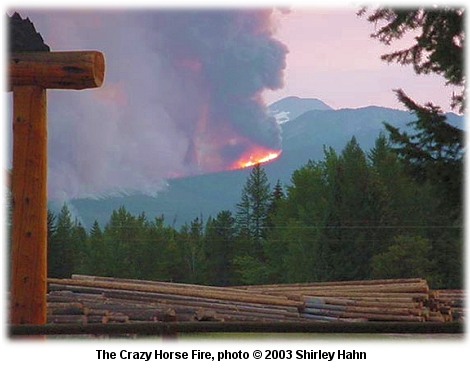
The Daily Inter Lake reported that fire bosses across the state share a common concern -- wind. Not the kind of sporadic wind that influences every fire -- they're worried about the kind of wind that can bend trees for days, winds that fit perfectly with fires lined up in east-west drainages. They are worried about the kind of winds that can turn a bad fire season into a catastrophe.
Active fires currently cover about 325,000 acres in Montana, but crews have thus far been spared the sort of winds that drove the infamous 1910 fires. Dave Bunnell, a 38-year fire veteran, says this is the time of year when the northern Rockies can experience a "Bermuda triangle of weirdness" when it comes to wind.
"We are set up," said Bunnell. "The last move required to have a repeat of these major fire events of the past is a major, long-term, sustained wind." Both Bunnell and Bob Mutch, a 50-year fire veteran, came out of retirement to help with the Northwest Montana Area Command group at the request of area commander Rex Mann.
They compiled a regional fire history, which was distributed to all incident commanders in the region. Mutch said they had six dry cold fronts in Yellowstone in 1988, and on August 20 that year the fires around Yellowstone grew by 152,000 acres. On August 29 and 30, the fires gained 172,000 acres. Between September 6 and 10, the fires gained a staggering 614,619 acres, an area that amounted to 36 percent of the 1.6 million acres burned around the park that summer.
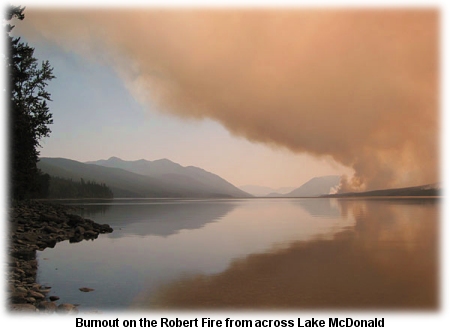
The benchmark for fires was the Big Blowup of 1910, which burned 3.5 million acres, with 75 percent of that acreage burning during one windy 36-hour period in August. When those fires were drenched by rain on the last day of August, they'd destroyed six towns in the region and killed 85 people -- including 78 firefighters.
Winds on Tuesday night pushed the Black Mountain 2 Fire near Missoula into a 200-acre run, and the Little Salmon Complex gained another 3,000 acres -- to a total of 38,500 acres.
The Great Falls Tribune reported that flare-ups were reported west of Missoula, near Lincoln, in Glacier National Park, and in the Bob Marshall Wilderness. Southwest of the Robert Fire, crews completed some crucial burnouts to protect the towns of Hungry Horse and Martin City from the 900-acre Beta Lake and Doris Ridge fires.
Rex Mann, area commander for the Blackfoot Lake Complex, Ball Creek, Wedge Canyon, Robert, Middle Fork Complex, Trapper Creek Complex, Crazy Horse, Rampage Complex, High and Little Salmon Creek Complex, said the forecast doesn't look good. "We are extremely concerned about the combination of severe weather conditions, changes in predicted weather, escalating fire behavior, and the large existing fires," he said.

WHAT'S NEXT? LOCUSTS?AUGUST 27 -- TUCSON, AZ: Homes along the Cañada del Oro Wash and parts of Sabino Canyon could be threatened by floods for years to come as land laid bare by the Aspen Fire sheds rainfall, and though the volume of ash washing down from the burned watershed will diminish, it could take years for the vegetation in the burn to recover.
Monsoonal storms in southern Arizona are now putting people at risk of drowning in the desert. The Arizona Daily Star reported that flooding has already claimed the life of publisher Jim Huntington, who was swept nearly a mile from his home near Oracle on August 15 after a wall of water washed down from the Santa Catalina Mountains.
On Monday night, almost two inches of rain fell on Mount Lemmon in less than an hour. Some forty homes were evacuated; another storm hit Tuesday afternoon, toppling powerlines and trapping six vehicles under live wires. The Cañada del Oro's flow was nearly 7,000 cubic feet per second, four times the 1993 flooding level.
According to the Tucson Citizen, the V&L Nursery suffered $80,000 worth of damage. The owner, Vaughn Hoffmeister, said the floodwaters pushed him about 100 feet when he tried to shut his gate. "This whole place was a river," he said. "It was ready to come into the house."
In a report by KGUN-TV, residents described the flooding after sheriff's deputies called for evacuations. "We have seen a lot of our friends' property going down the road," said Jennifer Canizales. "Water heaters and things like that. They're afraid. There's nothing up there to stop it from coming down here."
The Aspen Fire was one of three major wildfires in the Catalinas in the last two years that have burned 183 square miles above the Tucson metro area. The three largest fires this year in Arizona were the Aspen Fire at 84,750 acres, the 24,714-acre Kinishba Fire, and the 18,575-acre Blue River Complex, which included the Thomas and Steeple and Largo fires on the Apache-Sitgreaves National Forest.
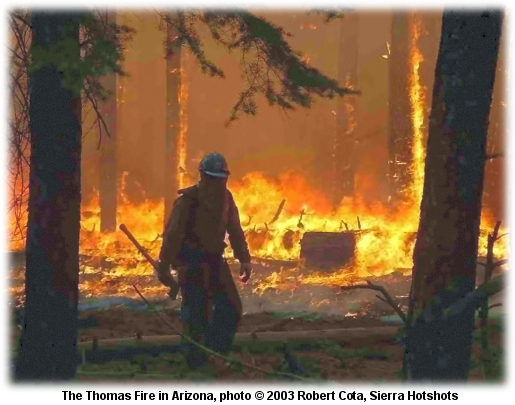
The steep and rocky terrain above Tucson -- like many areas of the Southwest desert -- quickly casts off water under normal conditions, but the fires changed conditions for the worse. Before the fires, rain was intercepted by the trees, shrubs, and forest duff. But the rain in the fire areas now falls on bare and blackened earth, where intense heat has made the ground water-repellent, dramatically increasing the likelihood of slides and flash flooding.
In northern Arizona, the National Weather Service on Monday issued a hazardous weather outlook through Thursday for Yavapai, Apache, Coconino, northern Gila, and Navajo counties.

NORTHEAST OREGON FIRES UPDATEAUGUST 26 -- LA GRANDE, OR: Though most of the fires burning in northeast Oregon have been contained, the Lightning Complex on the Wallowa-Whitman still includes several uncontained fires smoldering in heavy timber.
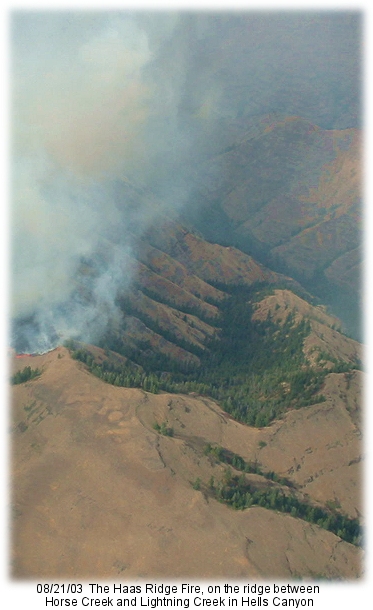 Morcom's Type 2 team is headquartered at the Joseph Rodeo Grounds, with 11 crews, five engines, five helicopters, six water tenders, and a total of 430 personnel. The complex includes the Grouse Creek, Haas Ridge, Butcherknife, and Two Corral fires. Morcom's Type 2 team is headquartered at the Joseph Rodeo Grounds, with 11 crews, five engines, five helicopters, six water tenders, and a total of 430 personnel. The complex includes the Grouse Creek, Haas Ridge, Butcherknife, and Two Corral fires.
The Haas Ridge Fire, on the ridge between Horse Creek and Lightning Creek in the Hells Canyon National Recreation Area, is now at 5,128 acres with 60 percent containment. The Two Corral Fire, two miles west of the Snake River near Two Corral Creek in the Wilderness, is 25 percent contained at 9,961 acres.
The Wallowa County Chieftain reported that the Two Corral is the largest in the complex; it's burned through mostly grass down to the Snake River, and is about two miles across. Containment is predicted for this weekend.
Andy White with the Oregon Department of Forestry said the success of the suppression effort is apparent in the fast containment of the Grouse Creek Fire, which had a good chance of spreading to private property. He said the intensive early strike effort kept it small.
"It was a tough save," he said, "a good save. It was a model of what you can do when you put agencies together. It kept the fire from getting on private lands; we could have been chasing a 2,000-acre fire."
The Two Corral Fire burned the historic Salt Creek Cabin Thursday night, despite protective fireline constructed around it. Structure protection is in place for a number of other sites in the HCNRA, including the Temperance Creek cabin. Fire burned to within a quarter-mile of the cabin.
Friday's heavy rain slowed fire activity on the Hazel Mountain Fire near Green Lake. The fire is burning in rocky terrain and is being managed under Wildland Fire Use. While all fires outside the Eagle Cap Wilderness are being suppressed, this fire is in monitor status.
A total of 16,436 acres were burned in the four fires of the Lightning Complex as of today, a week after they were started by lightning. Costs are estimated at $1,468,156 and full containment is expected by the end of August. More information is available from the Northeast Oregon Interagency Fire Center.

8 OREGON FIREFIGHTERS IDENTIFIEDAUGUST 25 -- ROSEBURG, OR: Six men from Douglas County and two others from Portland were identified today as the eight firefighters killed in a head-on collision with a semitrailer truck near Vale yesterday. Killed were Ricardo "Ricky" Ruiz, 19, of Roseburg; Mark Ransdell, 23, of Myrtle Creek; Jesse James, 22, of Roseburg; David Hammer, 38, of Portland; Leland Price Jr., 27, of Roseburg; Paul Gibson, 25, of Myrtle Creek; Richard B. Moore II, 21, of Portland and Jeff Hengel, 21, of Roseburg.
The two occupants of the semitrailer truck -- Stephen Anthony Nicholson, 37, and Joy L. Nicholson, 39, both of Ogden, Utah -- survived the crash, according to a Seattle Times report. They were taken to a hospital with dislocations and burns.
The eight firefighters had been assigned to the South Fork Fire in Idaho and were on their way home.
"I extend my wholehearted sorrow and sympathy to the families who lost their sons today," said Robert Krueger, president of First Strike Environmental, the company that employed the firefighters. "These were all fine young men who had worked together for two years. They were closer than most, and the hole they leave is enormous."
Roseburg Mayor Larry Rich said he was in shock. "It's one of those moments when it's unbelievable, that there's no way this could have happened," he said.
The van was traveling with another company van and a truck. Both those vehicles were about six miles ahead and did not see the crash. They came back to discover it after they lost radio contact with the van.

EIGHT OREGON FIREFIGHTERS KILLED ON HIGHWAYAUGUST 24 -- VALE, OR: A van with firefighters on their way home from a fire on the Boise National Forest collided late this morning near Vale, Oregon, with a semitrailer truck, killing eight crewmembers who worked for First Strike Environmental, a fire contractor out of Roseburg.
Malheur County Undersheriff Brian Wolfe said the van crossed a double-yellow line on a highway curve before it collided with the truck. Sheriff Andy Bentz said both people in the truck were injured and taken to a hospital in Ontario, Oregon.
Six of the firefighters were from Douglas County and two were from the Portland area. According to AP reports, the firefighters were traveling with another van that was ahead of them on the road. They were returning from the South Fork Fire on the Boise National Forest northeast of Cascade, Idaho.
The San Francisco Chronicle reported that the passengers in the lead vehicle did not see the crash. They drove back on the road after losing radio contact with the other van.

1994 PLAN CREDITED FOR CARNATION CONTAINMENTAUGUST 24 -- CARNATION, WA: Fifty engines and more than 170 firefighters from 20 different jurisdictions responded to a fire that threatened hundreds of homes here; though the fire reached only 30 acres, local fire officials say the same fire ten years ago would have been far more dangerous.
Before the state of Washington adopted its Fire Services Resource Mobilization Plan, resources would have been deployed more slowly, and the damage would have been much worse, according to Fire Chief Lee Soptich of Eastside Fire & Rescue. The plan was adopted in 1994 after a series of 92 fires -- the Spokane Firestorm -- killed a firefighter and destroyed 114 homes.
The King County Journal reported that state and local agencies developed the plan to unfold like a military operation; it divides fire response into tiers, with the local fire department as the first tier. Mutual aid with surrounding fire departments comes next, followed by 11 more zones in a four-county region, followed by nine more regions, followed by the state.
Initial attack on Thursday's incident saw the fire and called for reinforcements. They realized they would be overwhelmed and called for mutual aid. Then units from a neighboring zone were mobilized.
"Once they depleted those resources," said Soptich, "the Office of Emergency Management in King County got more units from the other two zones, Seattle and South King County."
That all occurred within the first half-hour.
"They were about half a step ahead by calling other places, lining up resources," said Soptich. "The system worked just beautifully."
Just two weeks ago, Eastside Fire & Rescue finished a structure protection plan for three communities. It specifies locations of water resources, escape routes, and other details.
The fire, according to King County Fire District, was started by fireworks. Remnants of a "ground bloomer," according to KOMO-TV, were found at the origin of the fire.

OREGON FIRES DOUBLE IN SIZE OVERNIGHTAUGUST 23 -- SISTERS, OR: Though cooler cloudy weather and light showers will help with fires in central Oregon, two wildfires near here doubled in size Thursday night to nearly 25,000 acres. Oregon Gov. Ted Kulongoski declared a state of emergency to bring on National Guard troops and heavy helicopters from the Air National Guard.
The B&B; Complex on the Deschutes National Forest comprises the Booth Fire and the Bear Butte Fire. Managed by Anderson's Type 1 team, the fires are about 14 miles west of Sisters in timber and heavy ground fuels. The community of Camp Sherman was evacuated, and structure protection is in place for 1,000 homes and 200 commercial
properties.
The Statesman-Journal reported that locals are worried about the closure of Highway 20 -- the town's lifeline linking the area to the west side of the state -- and the idea that Sisters is a fire-prone town best avoided during fire season.
"It's bloody awful," said Logan Godsiff, an employee at Eurosports, a mountain bike and outdoors store. "It happened the last time. When they close the highway, nobody bothers to come in."
Warm dry weather is expected through Tuesday, so the benefits of the tenth of an inch of rain the area saw will be short-lived. "It's going to slow down the spread and knock the heck out of the spotting potential," said Lori Hammer, fire information officer. "But this isn't going to touch the heavy fuels." Firefighters said the fire behavior Thursday was more severe than they had seen on other fires this summer.
The Booth Fire was estimated last night at more than 20,000 acres with zero percent containment, and the Bear Butte Fire is at about 4,000 acres. The Bend Bulletin reported that the Booth Fire burned 11 structures and two vehicles at the Round Lake Christian Camp, according to aerial recon. But Incident Commander Bob Anderson said they've been unable to confirm this because fire activity has been too intense to allow firefighter entry into the area.

10,000 EVACUATED IN BRITISH COLUMBIAAUGUST 22 -- KELOWNA, BC, CANADA: A fast-moving fire approaching the suburbs of Kelowna in southern British Columbia has forced the evacuation of 10,000 people in Okanagan Mountain Park since yesterday, when the fire jumped a firebreak near a residential area.
Reuters reported that emergency officials in Canada's westernmost province said it was their "worst-case scenario" when a 32,000-acre fire burning south of the city jumped a containment line and burned into a neighborhood of new and expensive homes last night. Local news reports said that as many as 20 homes may have been damaged or destroyed by the flames.
Winds were light this morning, but residents were worried by forecasts that called for winds to pick up later in the day with the possibility of thunderstorms.
Evacuees were being directed last night to two emergency reception centers set up in downtown Kelowna, a city of about 100,000.
A report in the San Francisco Chronicle said 110 firefighters and 11 helicopters were working on the fire, with 50 dozers trying to cut a line around the perimeter. The Okanagan Mountain park blaze is one of a half-dozen major fires burning in southern British Columbia. More than 3,000 firefighters, including hundreds of Canadian soldiers, are assigned. The British Columbia government on August 2 declared a state of emergency and issued a travel advisory asking people to avoid the southern British Columbia backcountry.

BOOK REVIEW: FIRE AND ASHESJUNE 18: John Maclean's done it again, only this time he's done it better. His first book, FIRE ON THE MOUNTAIN, was and still is a popular book with wildland firefighters. This one, though, will be a must-own for the summer army of boots-and-nomex firefighters -- and will surely be assigned as mandatory reading in many a fire training course.
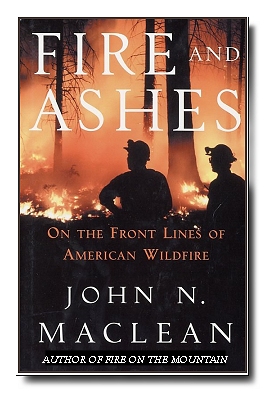 The collection of stories in FIRE AND ASHES proves up both Maclean's dogged pursuit of history and his determined focus on accuracy that comes from 30 years of journalism experience. Covering many thousands of miles, dozens of interviews, and painstaking attention to detail in his writing, Maclean has crafted a book that puts his readers out on the fireline. The collection of stories in FIRE AND ASHES proves up both Maclean's dogged pursuit of history and his determined focus on accuracy that comes from 30 years of journalism experience. Covering many thousands of miles, dozens of interviews, and painstaking attention to detail in his writing, Maclean has crafted a book that puts his readers out on the fireline.
Unlike many writers who try writing about wildfire, Maclean makes no lame allowances for readers who might not be familiar with the language and culture of the firefighter. He just explains it for them.
His recounting of the 1999 Sadler incident -- in retrospect a problematic compilation of small "oops" decisions that resulted in near-disaster -- is a chilling read when one considers how close it came to being a disaster like South Canyon. His "Short History of Wildland Fire" and glossary of fire terms will prove a useful go-to resource for firefighters -- structural and wildland both -- and for anyone curious enough to read about or write about fire.
It's Maclean's reconstruction of the 1953 Rattlesnake Fire, though, that stands as the highlight of the book. It's a can't-put-down story that's finally been accurately researched and told (and illustrated), about a fire that's been a benchmark for safety lessons and fire behavior training for 50 years. Young men and women in fire camps across the West -- and the older ones too -- will be packing this book along in their red bags this summer, and well they should.
| 






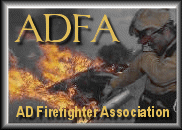

 The record-size Douglas-fir within the perimeter of the complex, contrary to rumor, was not killed by the fire.
The record-size Douglas-fir within the perimeter of the complex, contrary to rumor, was not killed by the fire.


 Weather problems and fire behavior are challenging suppression efforts on the Happy Camp Fire, the Happy Camp II Fire, and the Deafy Fire. Fire managers and making contingency plans for fires that are expected to burn together.
Weather problems and fire behavior are challenging suppression efforts on the Happy Camp Fire, the Happy Camp II Fire, and the Deafy Fire. Fire managers and making contingency plans for fires that are expected to burn together.
 One of dozens of fires burning in northern California after lightning storms last week, the Cod Complex is being managed by the
One of dozens of fires burning in northern California after lightning storms last week, the Cod Complex is being managed by the  The
The 

 Camp Sherman was evacuated again on Thursday when the fire burned to within three miles of the community.
Camp Sherman was evacuated again on Thursday when the fire burned to within three miles of the community.
 The largest of those today was the 170-acre Bowman Fire.
The largest of those today was the 170-acre Bowman Fire.






 Morcom's Type 2 team is headquartered at the Joseph Rodeo Grounds, with 11 crews, five engines, five helicopters, six water tenders, and a total of 430 personnel. The complex includes the Grouse Creek, Haas Ridge, Butcherknife, and Two Corral fires.
Morcom's Type 2 team is headquartered at the Joseph Rodeo Grounds, with 11 crews, five engines, five helicopters, six water tenders, and a total of 430 personnel. The complex includes the Grouse Creek, Haas Ridge, Butcherknife, and Two Corral fires.
 The collection of stories in FIRE AND ASHES proves up both Maclean's dogged pursuit of history and his determined focus on accuracy that comes from 30 years of journalism experience. Covering many thousands of miles, dozens of interviews, and painstaking attention to detail in his writing, Maclean has crafted a book that puts his readers out on the fireline.
The collection of stories in FIRE AND ASHES proves up both Maclean's dogged pursuit of history and his determined focus on accuracy that comes from 30 years of journalism experience. Covering many thousands of miles, dozens of interviews, and painstaking attention to detail in his writing, Maclean has crafted a book that puts his readers out on the fireline.